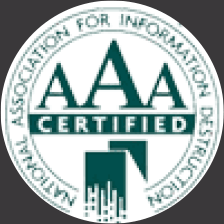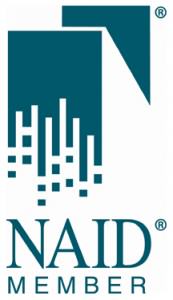
Once, data only took the form of paper, and destruction was as easy as shredding that paper until it was unable to be reconstructed. Now, most offices use a mix of data storage methods such as printed paper, email, and messaging tools such as Slack. This has made data disposal more difficult, and data less secure than ever.
Many companies are wondering how to dispose of data when it takes on so many unique forms. It is more important than ever to know about different forms of data destruction, so you can make sure your company is disposing of sensitive information in the most efficient and secure way possible.
So what is data disposal, and how can you make sure your data is safe from prying eyes?
What Is Data Disposal?
Data disposal refers to the act of completely destroying sensitive data beyond any hope of repair. This means paper documents are shredded, and not simply thrown away. It also means that hard drives are completely wiped or physically destroyed.
Simply deleting sensitive files is no guarantee that they will not be recovered in the future, as the information is still stored in the hard drive’s memory. Data needs to be completely wiped without any possibility of recovery to meet legal and ethical standards.
Why Data Disposal is Important
Data disposal is not just a good practice to follow for the success and security of your company – it is a legal obligation for most businesses. Federal privacy laws require data to be permanently destroyed after a certain period of time, to protect both your company and its employees. This is true for both paper documents and data stored on hard drives.
Disposal of business data is a fast-growing industry. Companies are now faced with surpluses of computers and hard drives that must be wiped in addition to paper documents.
Types of Data Disposal
Paper Shredding
Paper shredding is the simplest and most familiar form of data disposal. Perhaps your office is already equipped with a personal shredder. The act of paper shredding makes documents unreadable and allows them to be disposed of in bulk.
Paper shredding may seem as if it is on the verge of becoming obsolete, as most communication in the typical office happens via email or instant messaging. However, paper use is still widespread in American offices. The average office worker uses up to 10,000 sheets of paper per year, the equivalent of a 100-foot Douglas Fir tree.
The most innocuous printed-out email can contain sensitive or confidential information. It is important to shred paper documents on a regular basis, with an AAA-certified office shredding company.
Hard Drive Overwriting
Overwriting a hard drive is one of the most common forms of data destruction. It consists of writing over the data on an existing hard drive with a new pattern of data.
The advantage of overwriting is that the hard drives or electronics are still useable after being overwritten. They are essentially turned into new, blank products. However, overwriting has several distinct disadvantages.
First, it takes a lot of time to overwrite a hard drive. This may not be a problem for individual use, but if you have a company’s worth of data to dispose of, it can make overwriting too timely. When overwriting for legal purposes, a license ensuring the overwriting followed legal standards is required for each hard drive.
Second, overwriting is one of the least secure methods of data destruction. The overwritten data can often still be accessed in some form by a professional or by using certain software.
Hard Drive Degaussing
Degaussing is essentially exposing an electronic device to an extremely powerful magnet. The magnet disrupts the magnetic field of the electronic device, destroying the data within. Degaussing is much more efficient than overwriting, and more secure as well.
However, degaussing renders a device completely useless. If you wish to reuse your electronics after destroying the data, degaussing is not a good choice. There is also no way to thoroughly determine whether degaussing has worked without checking each machine individually.
Degaussing is also beginning to fall out of favor as hard drives are able to store information in smaller and smaller spaces. More efficient hard drives require more powerful magnets.
Physical Hard Drive Destruction
One of the most primitive-sounding forms of data destruction is also one of the safest – simply physically smashing or otherwise destroying a hard drive. This is the best way to ensure that your data is unrecoverable.
However, physical hard drive destruction is more than simply smashing a device with a hammer or dropping it from a tall building. Modern, AAA-certified data disposal companies use powerful industrial shredders to transform electronic items into small pieces of scrap metal.
Physical destruction is the most foolproof way to protect your data. Though it requires the disposal of the devices storing the data, there is absolutely no way for the data to be recovered. This is something neither overwriting nor degaussing can guarantee, making physical destruction the best choice for the disposal of business data.
Data Disposal for Your Company
Now that your “what is data disposal?” question is answered, you may be wondering about our data disposal services. We are fully certified members of the National Association for Information Destruction (NAID) as well as being certified in the highest level of data security.
We offer a full range of data disposal services including paper shredding, disposal of products (such as recalled or defective goods), and e-waste data destruction.
Call us today or use this form on our website to find out how we can make sure your data is safely destroyed.





